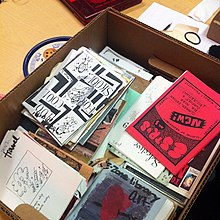
Back Zin Czech Zine German Ζιν Greek Zino Esperanto Zine Spanish مج (رسانه) Persian Zine ID Zine Italian ZINE Japanese Zine Dutch

A zine (/ziːn/ ZEEN; short for magazine or fanzine) is a small-circulation self-published work of original or appropriated texts and images, usually reproduced via a copy machine. Zines are the product of either a single person or of a very small group, and are popularly photocopied into physical prints for circulation. A fanzine (blend of fan and magazine) is a non-professional and non-official publication produced by enthusiasts of a particular cultural phenomenon (such as a literary or musical genre) for the pleasure of others who share their interest. The term was coined in an October 1940 science fiction fanzine by Russ Chauvenet and popularized within science fiction fandom, entering the Oxford English Dictionary in 1949.
Popularly defined within a circulation of 1,000 or fewer copies, in practice many zines are produced in editions of fewer than 100. Among the various intentions for creation and publication are developing one's identity, sharing a niche skill or art, or developing a story, as opposed to seeking profit. Zines have served as a significant medium of communication in various subcultures, and frequently draw inspiration from a "do-it-yourself" philosophy that disregards the traditional conventions of professional design and publishing houses, proposing an alternative, confident, and self-aware contribution.[1] Handwritten zines, or carbon zines, are individually made, emphasizing a personal connection between creator and reader,[1] turning imagined communities into embodied ones.[2]
Historically, zines have provided community for socially isolated individuals or groups through the ability to express and pursue common ideas and subjects. For this reason, zines have cultural and academic value as tangible traces of marginal communities, many of which are otherwise little-documented. Zines present groups that have been dismissed with an opportunity to voice their opinion, both with other members of their own communities or with a larger audience. This has been reflected in the creation of zine archives and related programming in such mainstream institutions as the Tate museum and the British Library.[3]
Written in a variety of formats from desktop-published text to comics, collages and stories, zines cover broad topics including fanfiction, politics, poetry, art & design, ephemera, personal journals, social theory, intersectional feminism, single-topic obsession, or sexual content far enough outside the mainstream to be prohibitive of inclusion in more traditional media. (An example of the latter is Boyd McDonald's Straight to Hell, which reached a circulation of 20,000.[4]) Although there are a few eras associated with zine-making, this "wave" narrative proposes a limited view of the vast range of topics, styles and environments zines occupied.
- ^ a b Triggs, Teal (2010). Fanzines The DIY Revolution. San Francisco, CA: Chronicle Books. ISBN 978-0-8118-7692-6.
- ^ Piepmeier, Alison (2008). "Why Zines Matter: Materiality and the Creation of Embodied Community". American Periodicals: A Journal of History, Criticism, and Bibliography. 18 (2): 213–238. doi:10.1353/amp.0.0004. S2CID 145377264.
- ^ Fife, Kirsty (2019). "Not for you? Ethical implications of archiving zines". Punk & Post Punk. 8 (2): 227–242. doi:10.1386/punk.8.2.227_1. S2CID 199233569 – via EBSCOhost.
- ^ William E. Jones, True Homosexual Experiences: Boyd McDonald and "Straight to Hell", Los Angeles: We Heard You Like Books, 2016, ISBN 9780996421812, p. 6.
© MMXXIII Rich X Search. We shall prevail. All rights reserved. Rich X Search